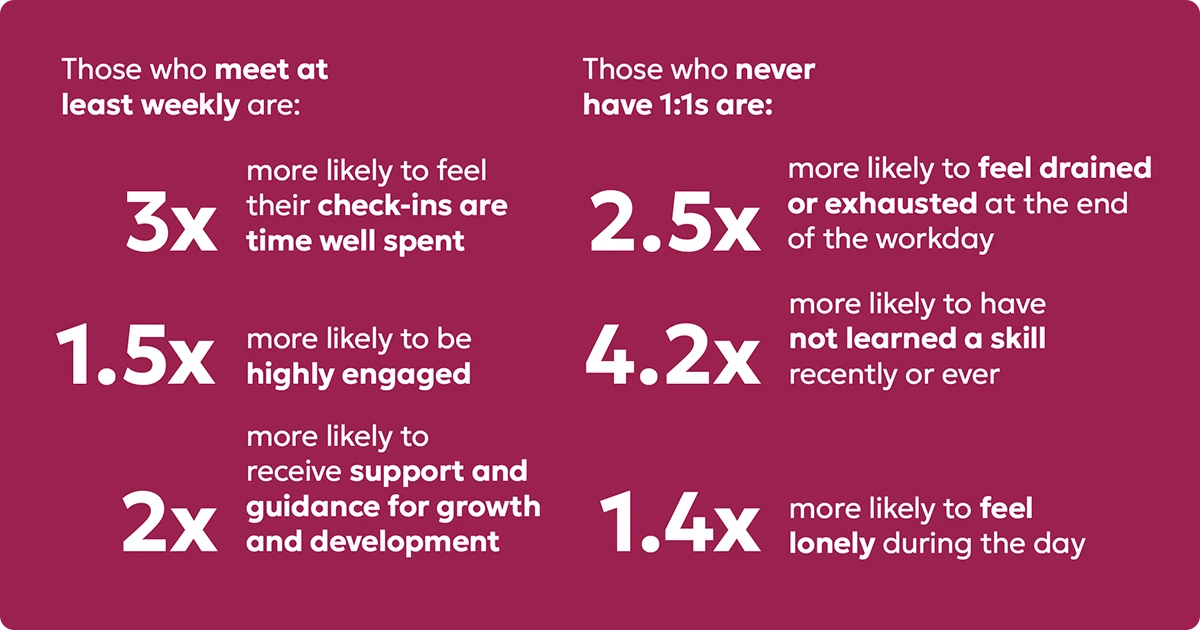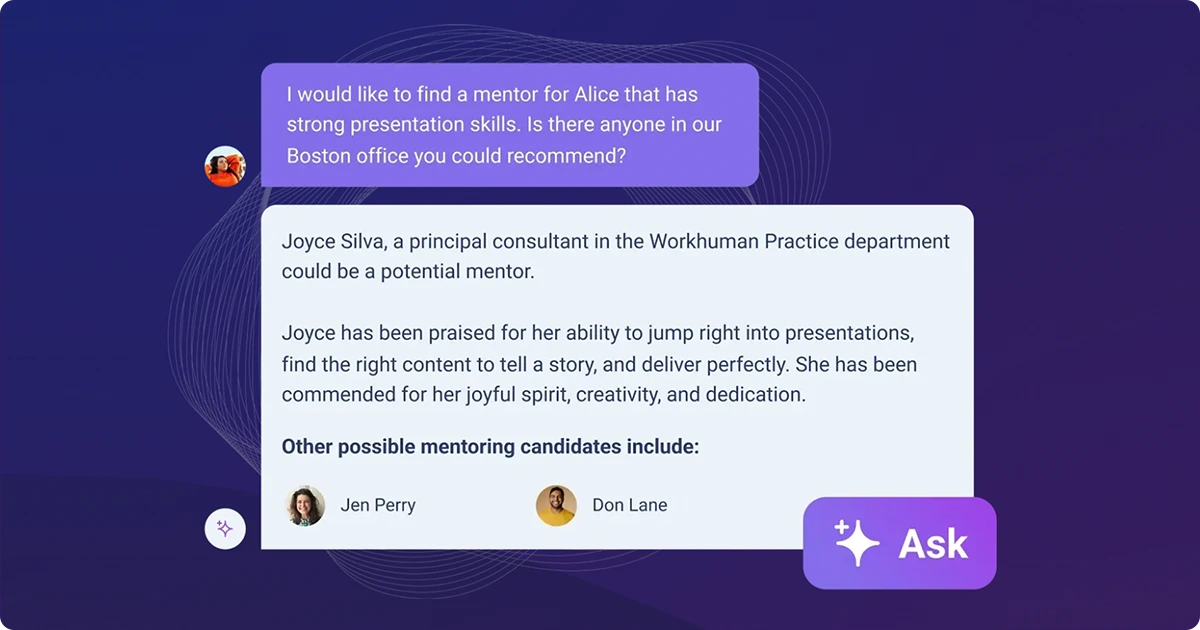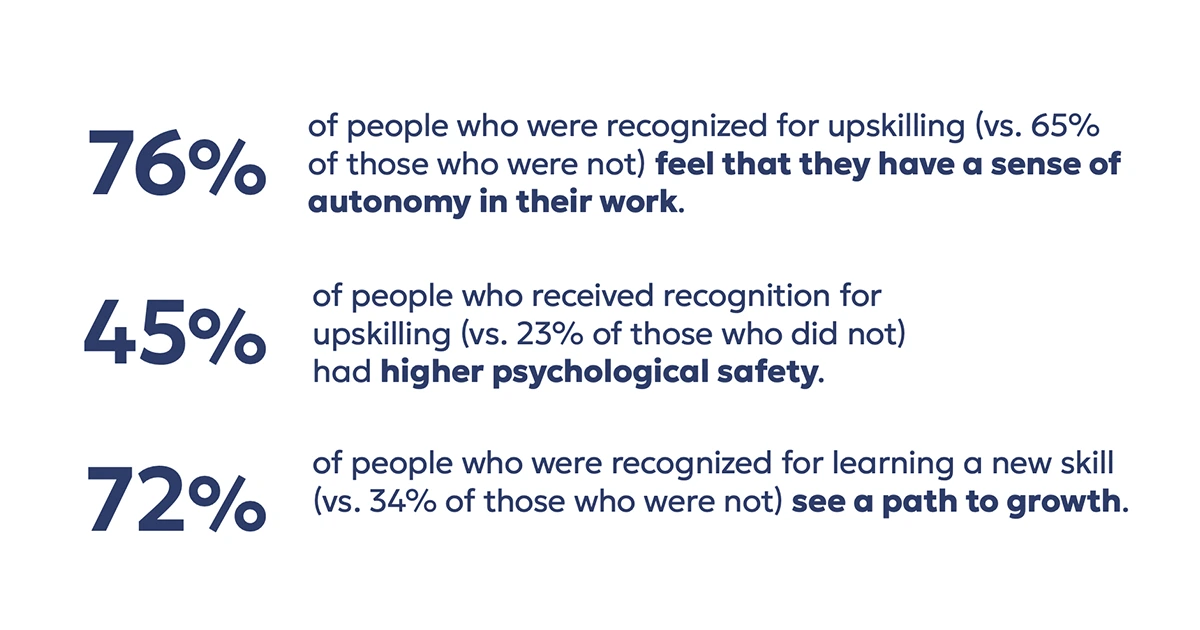Unlocking Potential: Steps to Create a Learning Culture

With the rapid pace of technology and forecasted changes to in-demand skills, keeping your workforce properly skilled is an important undertaking that dictates your company's success.
Unfortunately, our recent Workhuman iQ research found that 41% of individual contributors haven't learned a new skill in the last one to two years. The good news? Your employees want to learn.
63% of employees are unfamiliar with AI in the workplace. Discover how to upskill your workforce with the AI skills needed to thrive in the future.
Now, it's up to your organization to focus on creating a culture of learning. If keeping your workforce properly skilled is your goal, building a strong learning culture needs to be a priority – let's learn how to make it happen.
How to build an effective learning culture in your organization
Creating a culture of learning won't happen overnight; it takes intentionality and effort. Let's talk through what it takes to create a learning culture where everyone can thrive.
Step 1: Leadership commitment
A strong learning culture starts at the top. Leaders play a pivotal role in shaping the organization's mindset and behaviors. By modeling curiosity and a growth mindset, leaders can inspire their teams to embrace continuous learning.
In practice, leaders can model curiosity by regularly asking questions, actively seeking feedback from their team members, both positive and negative, and embracing challenges as opportunities to learn and grow rather than obstacles to overcome.
Highlight the importance of transparency in the workplace by using company-wide meetings and communications to openly share your own failures and the lessons you've learned from them. Beyond showing that you are open to growth and the challenges that come with it, it will promote open and honest communication at all levels of the organization and strengthen the trust your employees have in you.
Step 2: Create a safe and supportive environment
Learning requires time and mental energy. If you want your people to upskill, you need to create a space where they feel comfortable taking on that extra load. If your people are constantly working past core hours and spending their days in meeting after meeting just to meet company goals, how can you expect them to have the capacity to take in additional information?
Psychological safety, empathy, and understanding are critical when creating a culture of learning. To foster open communication and feedback, ensure that mangers are regularly checking in with their direct reports weekly. These meetings are a great time to gather information on what an employee might be interested in learning about and how they can fit it into their workload and goals.

Discover how revitalizing 1:1 check-ins can boost engagement and build a culture of appreciation in the workplace.
Another way to show employees that growth is a priority is to make learning and growth part of each and every employee's goals. Look beyond KPIs and see how building in time for employee growth and development will make their wins easier to achieve.
Step 3: Encourage curiosity and experimentation
Curiosity is the engine of innovation and learning. In practice, this might look like establishing regular meetings where teams and departments can share their plans, projects, and goals. It might look like discussing industry issues, feedback from customers, and anything else that could inspire curiosity and build connections between teams.
One way to show your employees that you value experimentation and risk-taking is to recognize and reward those who take a chance, even when plans don't work out. There's a lesson in every plan, no matter the outcome. Focus on creating a culture that is a safe place to fail.
Step 4: Provide opportunities for learning and development
The obvious one: Offer courses and learning opportunities to kickstart your culture of growth. One aspect that's not as obvious is the diversification and personalization of those opportunities. Leaders must be conscious of the fact that learning is personal and every learner is different.
In practice, this means offering blended learning options – such as a mix of mobile learning, on-demand learning, online learning, and in-person workshops – so that everyone can participate when it best suits their lives and workloads. There is a type of learning for everyone, by making development opportunities accessible you will make continuous learning easier and achievable.
Remember, learning is social. On top of the typical education opportunities, think about creating a continual professional development (CPD) program such as a corporate mentorship or coaching program to connect people within your organization. Workhuman's AI Assistant® can help match mentors and mentees in seconds with real-time data on who has skills in what area.

Workhuman's latest innovations make recognition done right easier than ever, with data visualizations of recognition distribution and custom nudges for managers to send out recognition at timely intervals.
Keep on top of organizational learning and development trends; technology is rapidly changing. Staying ahead of what's on the horizon is the only way to ensure your workforce is prepared. Otherwise, you'll be spending a lot of time playing catch-up and potentially face challenges such as needing to upskill and reskill entire teams and departments.
Step 5: Measure learning and development opportunities
We've all heard the infamous management quote, “If you can't measure it, you can't improve it.” Well, this applies to your organization's learning efforts as well. Find out more about the learning experience: What's working, where can you make improvements, and what do your people want to learn throughout the organization?
Focus on turning feedback into actionable outcomes by collecting strong data. To do so, format your employee surveys and pulse checks in a way that promotes safety and encourages transparency.
Frame questions in effective ways by making simple wording tweaks. For example, "How effective have the training programs been in helping you improve your skills and knowledge?" will lead to higher quality answers than, "Are you satisfied with the training programs offered by the company?"
Step 6: Celebrate learning and growth
Here at Workhuman, we prioritize "recognition done right." Our research with Gallup has found that when employee recognition is fulfilling, authentic, personalized, equitable, and embedded in company culture, there is a proven boost to workplace culture, retention, and engagement.
Discover strategies and insights in our research to foster a human-centered workplace focused on recognition and resilience.
Our latest Workhuman iQ research found that receiving recognition for upskilling has a profound effect on an employee's psychological safety, sense of autonomy, and whether they see a path to growth in their organization. A simple shout-out makes a big impact; and encourages leaders and managers to appreciate the effort and time employees are putting into upskilling.

Conclusion
Creating a learning culture is a journey, not a destination. It requires a commitment from leadership to prioritize learning and development. Offering a diverse range of programs, from formal training to informal mentoring, will empower employees to reach their full potential.
Foster a robust learning culture where growth and effort are celebrated and encouraged. By recognizing and rewarding employees for their achievements, organizations can reinforce the value of continuous learning, unlock the potential of their workforce, drive innovation, and achieve sustainable success.
About the author
Alicyn Zall
Alicyn Zall is a writer dedicated to creating a more equitable and fulfilling workplace. With a focus on actionable, data-driven insights, her work empowers individuals and organizations to foster positive change. In addition to her contribution at Workhuman, Alicyn has served as an editor at Harvard Business Review where she developed books and articles about mental health and the future of work.